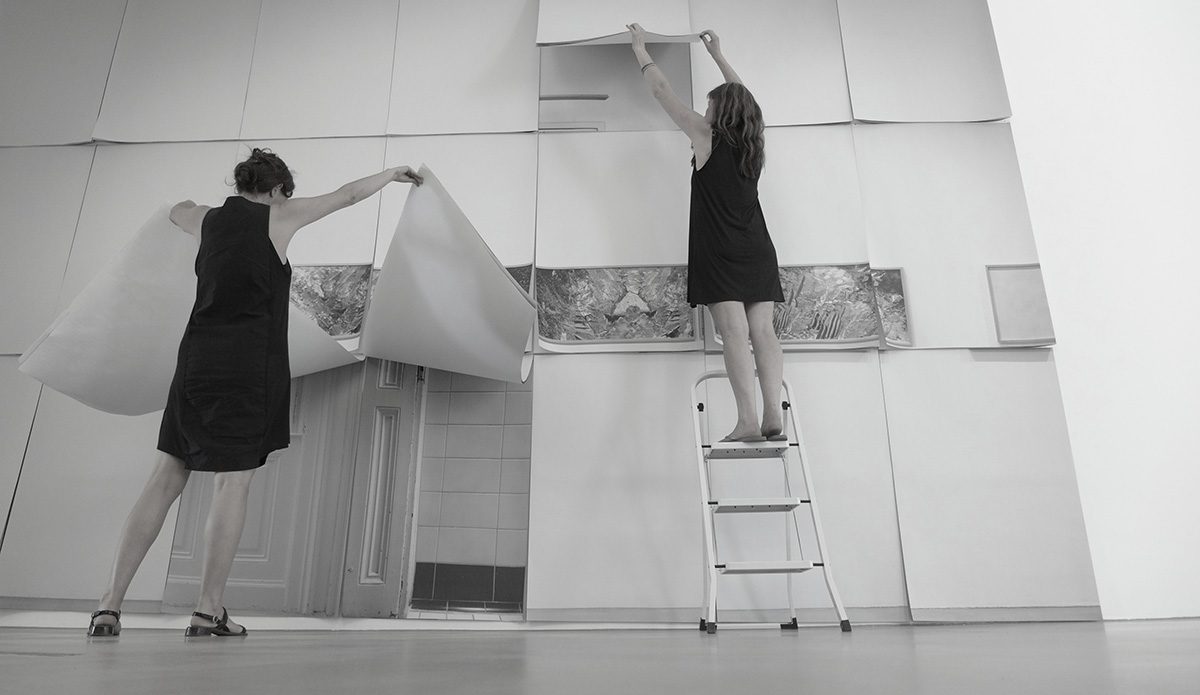cadavre exquis, 2016
Wall piece consisting of 200 black-and-white posters à 120×80 cm
With her work, Claudia Märzendorfer sets sculptur(es) in motion and creates situations that due to their volatility entail moments of surprise. Her sculptural works produced in form of casts of frozen water and ink, are exemplary for this approach. In turn, she segments and slits up space in pictures and in doing so, deconstructs familiar viewing habits. In life-size wall drawings and in photographic 1:1 reproductions the artist literally scans rooms. For this, the spaces are first visually captured and divided into sections according to a defined grid, only to then re-assemble the photographic reproductions in a new way. For Märzendorfer, this mode of spatial exploration constitutes a possibility of understanding. The more general question of how we conceive the world and shape our surroundings runs like a common thread through her oeuvre.
The large-format wall piece cadavre exquis, which Claudia Märzendorfer realised in 2016, shows a section of a suite of rooms that runs through the former post office building in Bregenz, which was defined and documented in a series of photographs by the artist. The building now hosts, among others, the Bildraum Bodensee gallery, where the work that consists of 200 black-and-white posters was presented.
For the site-specific collage, 200 life-size photographs were plotted on 120 x 80 cm large sheets of 80 grms paper, sorted and piled and then nailed to the wall. In multiple layers and dense rows the posters hung one upon the other and side by side on the wall, and together created an overall picture of the suite of rooms.
The height was given in three rows – A (top), B (middle), C (bottom), the width was organised in seven columns, while the depth of the photographed space could vary and defined the number of layers of posters. Visitors were invited to flip through the images, to reveal those poster images that lay beneath the top layer, possibly also to pull off a poster and to take it with them, and in doing so they modified the overall image each time. For ever new visual combinations and random views were created, comparable to the playful method of producing images and texts practiced by the Surrealists, which they named cadavre exquis.
For the publication in hand, which is conceived as documentation of the poster piece that spread across the whole wall and is published as edition of 100 copies, the concept of fragmentation and spatial reconfiguration (as described above) has been taken a step further, this time in order to adapt the photographic reproduction of the suite of rooms for the linear structure of a bound printed work.
Here, instead of their simultaneous order from top to bottom, next to and behind one another on the wall, the in total 21 batches of posters are organised and bundled that, when turning the pages one is lead from the position top left (A1) to bottom right (C7). Each turn the pages first follow the order of layers (depth) and only then switch to the next batch of pictures in reading direction, and this pattern is repeated until the last batch. As a result, the publication is structured in 21 segments divided by inserted sheets with according captions. Depending on the number of walls that are located in row in the respective spatial alignment, the sections count more or less pages.
Jeanette Pacher





